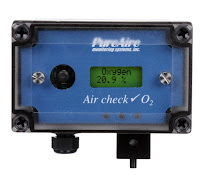If you're wondering how to
monitor oxygen levels in a room, look no further than an oxygen monitor. Learn
how to use an oxygen monitor, where you install an oxygen monitor, and why this
one little device could save a life.
Why Should I Measure
Oxygen Levels in a Room?
Before we can answer the
question of how to measure oxygen levels in a room, we must look at why you're
measuring oxygen levels in a room.
Humans need oxygen to breathe.
The air's natural oxygen concentration is around 21 percent; however, natural
oxygen in the air can be displaced by certain gases, including nitrogen and
argon. If nitrogen were to leak in a closed space, oxygen levels would
fall. Since nitrogen and other inert gases have no color or odor, it's not as
if you can spot a nitrogen leak occurring.
When oxygen levels fall below
the safe threshold, which is 19.5 percent, health hazards may occur. With only
a few breaths of oxygen deficient air, you could fall unconscious and suffocate.
Given these safety risks, leak detection systems are necessary.
What is an Oxygen
Monitor?
An oxygen monitor is a device
that measures oxygen levels in the room, to ensure the air has enough oxygen
for respiration. Also called an oxygen deficiency monitor or an O2 monitor,
an oxygen monitor uses a sensor to measure oxygen levels. By tracking oxygen
levels, gas leaks can be detected even though the leaking substance cannot be
seen or smelled.
Oxygen monitors come with a
range of features, including built-in alarms that go off when leaks occur.
There is usually a loud alarm (designed to be heard over machine noise) as well
as a flashing light.
Oxygen levels differ in their
setup and maintenance needs, which makes the question of how to use an oxygen
monitor a little more challenging to answer. Some brands of oxygen monitor
require annual maintenance and calibration. Other styles of oxygen monitor,
such as those sold at PureAire, do not need calibration after
installation. PureAire's O2 monitors are designed to
work efficiently and accurately for 10 or more year after installation, saving
time and money.
Where You Install an
Oxygen Monitor?
Oxygen monitors should be
installed anywhere there is a risk of gas leaks. Place one oxygen monitor in
any room where you store inert gases and in any room where these gases are
used. This way, if you have a helium, argon, or nitrogen spill -- for
instance, in a university science lab -- the oxygen sensor will detect the
lower levels of oxygen and sound the alarm.
How do You Install an
Oxygen Monitor?
Oxygen monitors can be mounted
on the wall using a bracket and screw, then connected via plug-in-the-wall
power supply. Alternately, oxygen monitors can be hardwired with the services
of an electrician. It's your choice. We recommend that oxygen monitors be
installed 3 to 5 feet off the ground, and 3 to 5 feet away from any obstacle,
such as a gas tank.
Oxygen monitors deliver peace of
mind that your employees and your facility are protected from the hazardous
side effects of a gas leak. They may be required by industry regulations. To
get an industry-leading oxygen monitor that's maintenance-free, look
to PureAire.


No comments:
Post a Comment